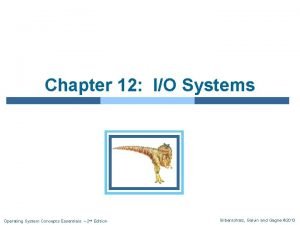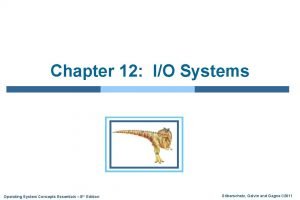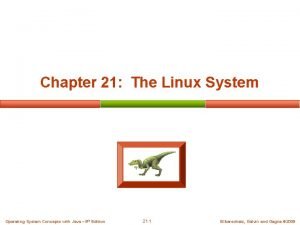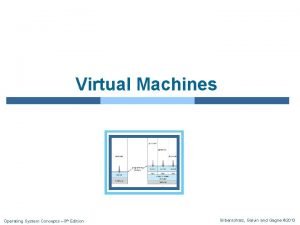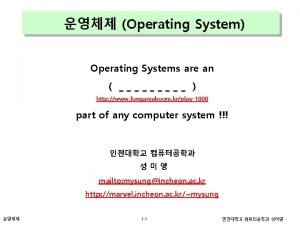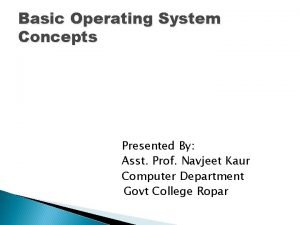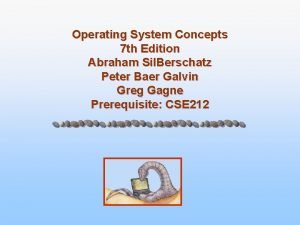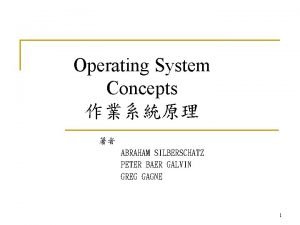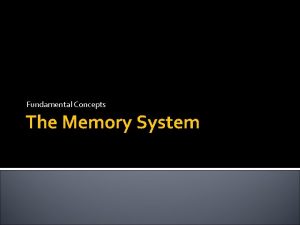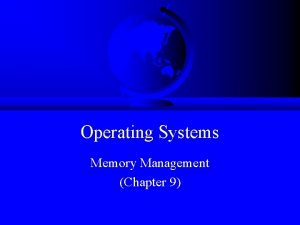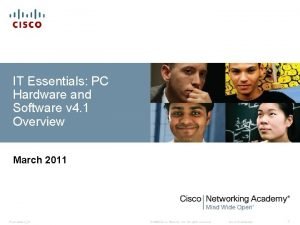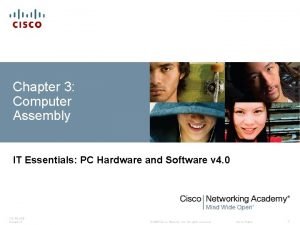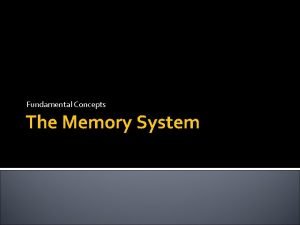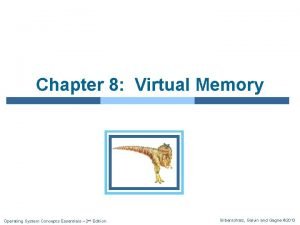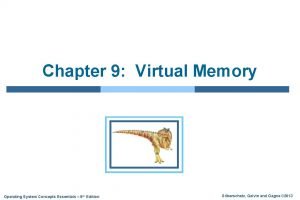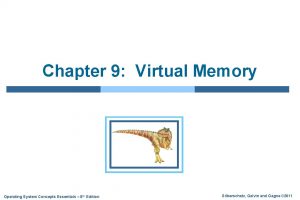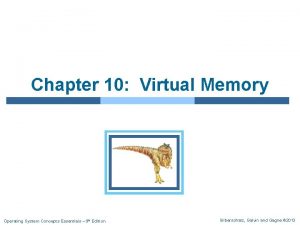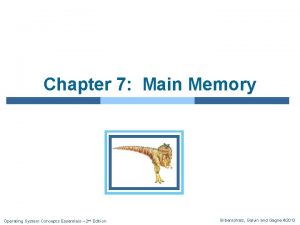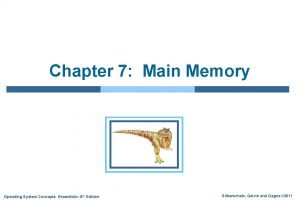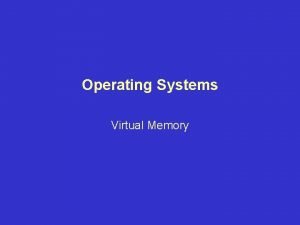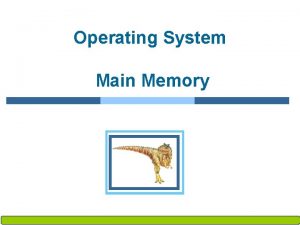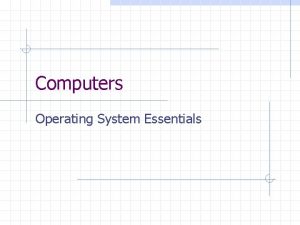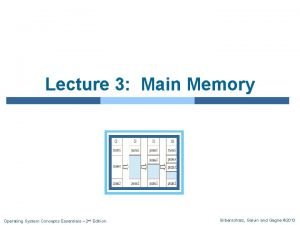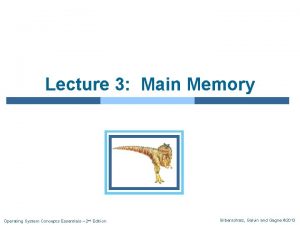Chapter 9 Virtual Memory Operating System Concepts Essentials
























- Slides: 24

Chapter 9: Virtual Memory Operating System Concepts Essentials – 9 th Edition Silberschatz, Galvin and Gagne © 2013

Chapter 9: Virtual Memory n Background n Demand Paging n Copy-on-Write n Page Replacement Operating System Concepts Essentials – 9 th Edition 9. 2 Silberschatz, Galvin and Gagne © 2013

Objectives n To describe the benefits of a virtual memory system n To explain the concepts of demand paging, page-replacement algorithms, and allocation of page frames n To examine the relationship between shared memory and memory-mapped files Operating System Concepts Essentials – 9 th Edition 9. 3 Silberschatz, Galvin and Gagne © 2013

Background n Code needs to be in memory to execute, but entire program rarely used l Error code, unusual routines, large data structures n Entire program code not needed at same time n Consider ability to execute partially-loaded program l Program no longer constrained by limits of physical memory l Each program takes less memory while running -> more programs run at the same time 4 l Increased CPU utilization and throughput with no increase in response time or turnaround time Less I/O needed to load or swap programs into memory -> each user program runs faster Operating System Concepts Essentials – 9 th Edition 9. 4 Silberschatz, Galvin and Gagne © 2013

Background n Virtual memory – separation of user logical memory from physical memory l Only part of the program needs to be in memory for execution l Logical address space can therefore be much larger than physical address space l Allows address spaces to be shared by several processes l Allows for more efficient process creation l More programs running concurrently l Less I/O needed to load or swap processes n Virtual address space – logical view of how process is stored in memory l Usually start at address 0, contiguous addresses until end of space l Meanwhile, physical memory organized in page frames l MMU must map logical to physical n Virtual memory can be implemented via: l Demand paging l Demand segmentation Operating System Concepts Essentials – 9 th Edition 9. 5 Silberschatz, Galvin and Gagne © 2013

Virtual Memory That is Larger Than Physical Memory Operating System Concepts Essentials – 9 th Edition 9. 6 Silberschatz, Galvin and Gagne © 2013

Shared Library Using Virtual Memory Operating System Concepts Essentials – 9 th Edition 9. 7 Silberschatz, Galvin and Gagne © 2013

Demand Paging n Could bring entire process into memory at load time n Or bring a page into memory only when it is needed l Less I/O needed, no unnecessary I/O l Less memory needed l Faster response l More users n Similar to paging system with swapping (diagram on right) n Page is needed reference to it l invalid reference abort l not-in-memory bring to memory n Lazy swapper – never swaps a page into memory unless page will be needed l Swapper that deals with pages is a pager Operating System Concepts Essentials – 9 th Edition 9. 8 Silberschatz, Galvin and Gagne © 2013

Basic Concepts n With swapping, pager guesses which pages will be used before swapping out again n Instead of swapping in a whole process, pager brings in only those pages into memory n How to determine that set of pages? l Need new MMU functionality to implement demand paging n If pages needed are already memory resident l No difference from non demand-paging n If page needed and not memory resident l Need to detect and load the page into memory from storage 4 Without changing program behavior 4 Without programmer needing to change code Operating System Concepts Essentials – 9 th Edition 9. 9 Silberschatz, Galvin and Gagne © 2013

Valid-Invalid Bit n With each page table entry a valid–invalid bit is associated (v in-memory – memory resident, i not-in-memory) n Initially valid–invalid bit is set to i on all entries n Example of a page table snapshot: Frame # valid-invalid bit v v i …. i i page table n During MMU address translation, if valid–invalid bit in page table entry is i page fault Operating System Concepts Essentials – 9 th Edition 9. 10 Silberschatz, Galvin and Gagne © 2013

Page Table When Some Pages Are Not in Main Memory Operating System Concepts Essentials – 9 th Edition 9. 11 Silberschatz, Galvin and Gagne © 2013

Page Fault n If there is a reference to a page, first reference to that page will trap to operating system: page fault 1. Operating system looks at another table to decide: l Invalid reference abort l Just not in memory 2. Find free frame 3. Swap page into frame via scheduled disk operation 4. Reset tables to indicate page now in memory Set validation bit = v 5. Restart the instruction that caused the page fault Operating System Concepts Essentials – 9 th Edition 9. 12 Silberschatz, Galvin and Gagne © 2013

Steps in Handling a Page Fault Operating System Concepts Essentials – 9 th Edition 9. 13 Silberschatz, Galvin and Gagne © 2013

Aspects of Demand Paging n Extreme case – start process with no pages in memory l OS sets instruction pointer to first instruction of process, non-memory-resident -> page fault l And for every other process pages on first access n Hardware support needed for demand paging l Page table with valid / invalid bit l Secondary memory (swap device with swap space) l Instruction restart Operating System Concepts Essentials – 9 th Edition 9. 14 Silberschatz, Galvin and Gagne © 2013

What Happens if There is no Free Frame? n Used up by process pages n Also in demand from the kernel, I/O buffers, etc n How much to allocate to each? n Page replacement – find some page in memory, but not really in use, page it out l Algorithm – terminate? swap out? replace the page? l Performance – want an algorithm which will result in minimum number of page faults n Same page may be brought into memory several times Operating System Concepts Essentials – 9 th Edition 9. 15 Silberschatz, Galvin and Gagne © 2013

Basic Page Replacement 1. Find the location of the desired page on disk 2. Find a free frame: - If there is a free frame, use it - If there is no free frame, use a page replacement algorithm to select a victim frame - Write victim frame to disk if dirty 3. Bring the desired page into the (newly) free frame; update the page and frame tables 4. Continue the process by restarting the instruction that caused the trap Operating System Concepts Essentials – 9 th Edition 9. 16 Silberschatz, Galvin and Gagne © 2013

Page Replacement Operating System Concepts Essentials – 9 th Edition 9. 17 Silberschatz, Galvin and Gagne © 2013

Page and Frame Replacement Algorithms n Frame-allocation algorithm determines l How many frames to give each process l Which frames to replace n Page-replacement algorithm l Want lowest page-fault rate on both first access and re-access n Evaluate algorithm by running it on a particular string of memory references (reference string) and computing the number of page faults on that string l String is just page numbers, not full addresses l Repeated access to the same page does not cause a page fault l Results depend on number of frames available n In all our examples, the reference string of referenced page numbers is 7, 0, 1, 2, 0, 3, 0, 4, 2, 3, 0, 3, 2, 1, 2, 0, 1, 7, 0, 1 Operating System Concepts Essentials – 9 th Edition 9. 18 Silberschatz, Galvin and Gagne © 2013

Graph of Page Faults Versus The Number of Frames Operating System Concepts Essentials – 9 th Edition 9. 19 Silberschatz, Galvin and Gagne © 2013

First-In-First-Out (FIFO) Algorithm n Reference string: 7, 0, 1, 2, 0, 3, 0, 4, 2, 3, 0, 3, 2, 1, 2, 0, 1, 7, 0, 1 n 3 frames (3 pages can be in memory at a time per process) 15 page faults n Can vary by reference string: consider 1, 2, 3, 4, 1, 2, 5, 1, 2, 3, 4, 5 l Adding more frames can cause more page faults! 4 n Belady’s Anomaly How to track ages of pages? l Just use a FIFO queue Operating System Concepts Essentials – 9 th Edition 9. 20 Silberschatz, Galvin and Gagne © 2013

FIFO Illustrating Belady’s Anomaly Operating System Concepts Essentials – 9 th Edition 9. 21 Silberschatz, Galvin and Gagne © 2013

Optimal Algorithm n Replace page that will not be used for longest period of time l n How do you know this? l n 9 is optimal for the example Can’t read the future Used for measuring how well your algorithm performs Operating System Concepts Essentials – 9 th Edition 9. 22 Silberschatz, Galvin and Gagne © 2013

Least Recently Used (LRU) Algorithm n Use past knowledge rather than future n Replace page that has not been used in the most amount of time n Associate time of last use with each page n 12 faults – better than FIFO but worse than OPT n Generally good algorithm and frequently used n But how to implement? Operating System Concepts Essentials – 9 th Edition 9. 23 Silberschatz, Galvin and Gagne © 2013

End of Chapter 9 Operating System Concepts Essentials – 9 th Edition Silberschatz, Galvin and Gagne © 2013
 Operating system concepts essentials
Operating system concepts essentials Operating system concepts essentials
Operating system concepts essentials Virtual memory in os
Virtual memory in os Demand paging in virtual memory
Demand paging in virtual memory Operating system concepts chapter 8 solutions
Operating system concepts chapter 8 solutions Operating system concepts chapter 5 solutions
Operating system concepts chapter 5 solutions Operating system concepts chapter 5 solutions
Operating system concepts chapter 5 solutions Page fault
Page fault Virtual memory in memory hierarchy consists of
Virtual memory in memory hierarchy consists of Operating system
Operating system Linux operating system concepts
Linux operating system concepts Operating system concepts with java
Operating system concepts with java Operating system concepts 6th edition
Operating system concepts 6th edition Type 0 hypervisor
Type 0 hypervisor Realtime operating system
Realtime operating system 교보 drm
교보 drm Basic operating system concepts
Basic operating system concepts Operating system concepts 11th
Operating system concepts 11th Operating system abraham silberschatz
Operating system abraham silberschatz Basic concepts of memory
Basic concepts of memory Memory management operating system
Memory management operating system It essentials pc hardware and software
It essentials pc hardware and software Cisco it essentials virtual desktop pc assembly online
Cisco it essentials virtual desktop pc assembly online Operating systems
Operating systems Basic concepts of memory
Basic concepts of memory
